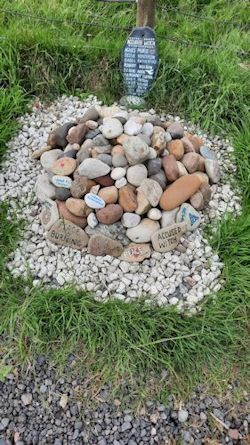Scotland’s Year of Stories
Heaven and Hell, Stories
of hope and despair in Kinross-shire
 The
Crook of Devon Witch Trials, 1662
The
Crook of Devon Witch Trials, 1662
It seems
there have always been witches.
At one time, they were seen as normal members of society. People would
consult them for a spell or potion, to cure some illness in themselves
or a family member – or to rid themselves of some misfortune or
mischief. Often, these witches would have great knowledge of medicinal
or poisonous plants.
This all changed in the time of Mary, Queen of Scots. Witches came to
be seen as worshippers of the devil, meeting together in covens and seeking
to do harm to people. Queen Mary introduced a Witchcraft Act in 1563.
Her son, James VI of Scotland, was very fearful of witches. He strongly
believed that he had enemies who sought to do him great harm, and that
they could do this by witchcraft. He even wrote a book on the subject,
“The Daemonologie”.
People were urged to seek out likely witches and across Scotland many,
many hundreds, (possibly thousands) were accused of witchcraft. There
were so many that the courts could not manage all the trials, and so ‘men
of high standing’ could hold trials locally. It was always men who
were judge and jury; and invariably - though not always – women
who were accused of witchcraft.
The accused would often be those seen to be a bit odd. Outsiders, single
women living alone, maybe grumpy or withdrawn. They would often have that
knowledge of healing or poisonous plants.
It was believed that witches never acted alone. So, it was vital that
an accused witch should reveal the names of the rest of the coven. Also,
the accusers needed to know what the devil looked like. Interrogations
were very unpleasant, and, if found guilty they were put to death. Witchprickers
were employed – to prick the accused. If they did not bleed immediately,
that was powerful proof that they were guilty. Other symptons of guilt
that could be found on someone’s body were moles or a third nipple.
One such local trial, judged by men of high standing, was held in Crook
of Devon in 1662. Many of these men firmly believed that the accused were
indeed all witches. These men included the ministers of Kinross, Cleish
and Muckhart parish churches as well as William Halliday, Laird of Tullibole.
There were 12 accused, one man and 11 women. 11 were found guilty and
put to death. The executions took place at Lamblaires, Crook of Devon.
What happened to the 12th, Margaret Hoggan, is not known. She was very
elderly, and may have been spared, or died during the interrogation or
trial.
The others were: Agnes Murie, Margaret Lister, Janet Paton, Kilduff. Bessie Henderson, Pitfar. Isabella Rutherford, Robert Wilson, Janet Paton, Bessie Neil, Janet Brugh, Crook of Devon. Agnes Brugh, Gooselands, Christian Grieve
The confessions:
all admitted to meeting with and worshipping the devil, sometimes alone,
sometimes with others. They had to describe what the devil looked like.
Bessie Neil also confessed that she and Janet Paton had trampled down
a field of rye belonging to Thomas Whyte before the harvest of 1661. Because
Janet Paton had the biggest feet, she had done the most damage.
Robert Wilson confessed to meeting with the devil along with most of his
co- accused and some other women. Once, when he had a pain in his side,
he went to see Isabella Rutherford who charmed him and made him feel better.
Isabel Rutherford was accused by Janet Hutton that, 10 years earlier,
when Janet Hutton’s husband was ill, Isabel Rutherford had visited
him and made him worse. Also, that, 12 years earlier, Isabel Rutherford
had visited James Kid of Muirhaugh, and made his illness worse, not better,
and that he had been ill ever since.
The present day Laird of Tullibole has created a maze and pentagon as
a memorial to the injustice suffered by these victims. There is, also,
a memorial to the victims in Crook of Devon.
Places that relate to these events:
Tullibole Maze
Tullibole Cemetery, Stannerigate, Gibson’s Craig – all places
where witches’ covens were said to meet
Lamblaires, Crook of Devon - memorial to the executions there
The farms, villages where the accused lived
Link
to the work produced by local children for the exhibition
Link to pages 1 &
4 of the leaflet
Link to pages 2 &
3 of the leaflet
This event has been supported by the Year of Stories 2022 Community Stories Fund. This fund is being delivered in partnership between VisitScotland and Museums Galleries Scotland with support from National Lottery Heritage Fund thanks to National Lottery players.
